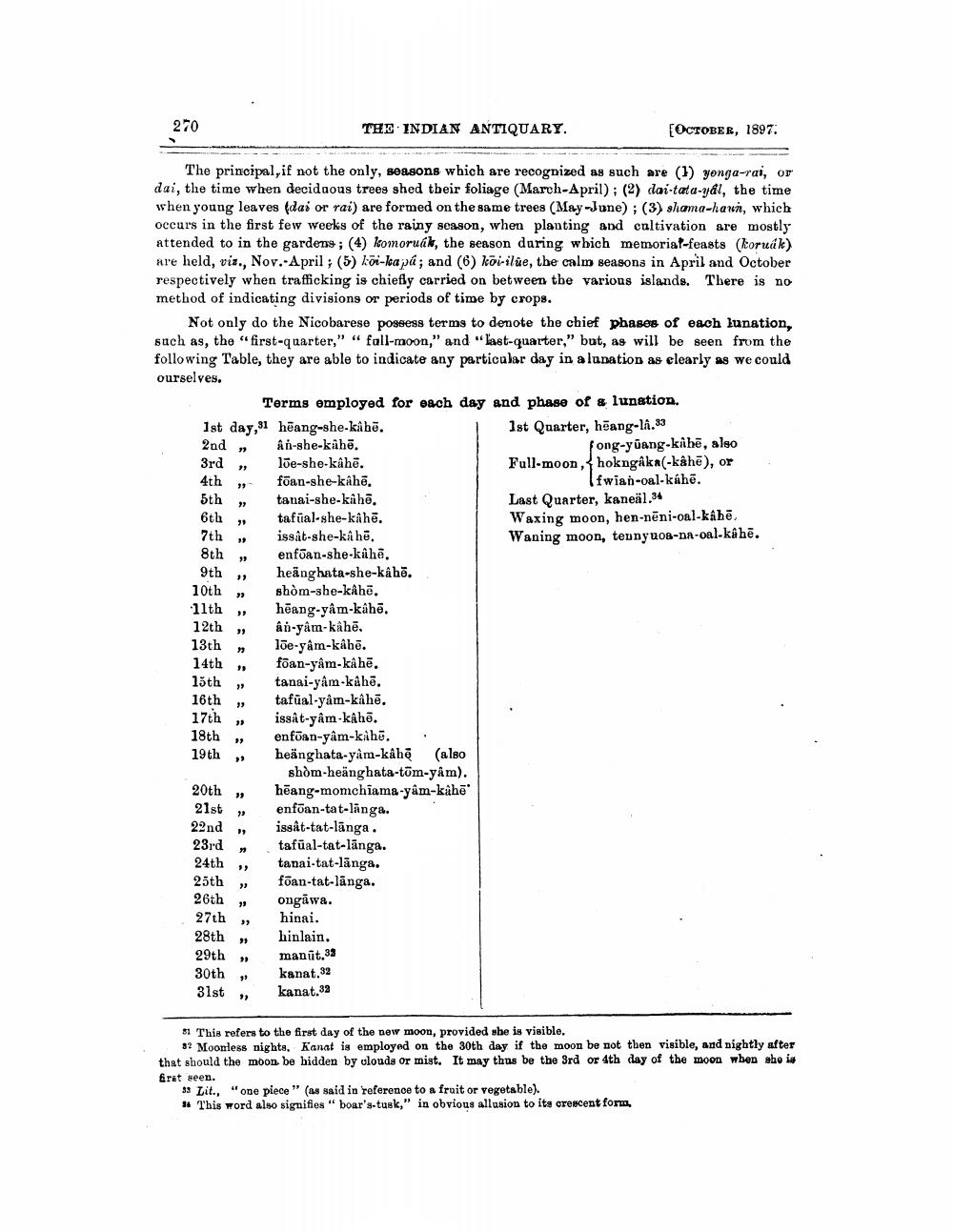________________
270
The principal, if not the only, seasons which are recognized as such are (1) gonga-rai, or dai, the time when deciduous trees shed their foliage (March-April); (2) dai-tata-yal, the time when young leaves (dai or rai) are formed on the same trees (May-June); (3) shama-haun, which occurs in the first few weeks of the rainy season, when planting and cultivation are mostly attended to in the gardens; (4) komoruak, the season during which memorial-feasts (koruak) are held, viz., Nov.-April; (5) koi-kapá; and (6) koi-ilue, the calm seasons in April and October respectively when trafficking is chiefly carried on between the various islands. There is no method of indicating divisions or periods of time by crops.
1st day,
2nd
Not only do the Nicobarese possess terms to denote the chief phases of each lunation, such as, the "first-quarter," "fall-moon," and "last-quarter," but, as will be seen from the following Table, they are able to indicate any particular day in a lunation as clearly as we could ourselves.
3rd
4th
5th
6th
7th
8th
16th
17th
18th
19th
""
20th
21st
22nd
23rd
24th
39
9th
10th " 11th
12th
13th
14th
15th
39
39
33
"2
33
33
33
39
"
""
25th
26th 27th
28th
29th 30th 31st "
23
دو
THE INDIAN ANTIQUARY.
33
39
[OCTOBER, 1897.
Terms employed for each day and phase of a lunation.
1st Quarter, hang-lâ.33
fong-yuang-kahe, also Full-moon, hokngâka(-kâhe), or fwian-oal-kahe.
heang-she-kâhe. ân-she-kâhe.
lõe-she-kâhe.
fōan-she-kâhe.
tanai-she-kâhe. tafual-she-kâhe. issât-she-kâhe. enfüan-she-kâhē. heänghata-she-kâhe. shòm-she-kâhe.
hoang-yhm-kihô ai-yâm-kahe.
le-ym-kib.
fōan-yâm-kâhē. tanai-yâm-kâhe. tafual-yâm-kâhe. issât-yâm-kâhe. enfüan-yâm-kahe.
heänghata-yam-kâhē (also shom-heinghata-tʊm-ykm).
heang-momchiama-yâm-kahē enföan-tat-länga.
issât-tat-länga.
tafual-tat-länga.
tanai-tat-länga. föan-tat-länga. ongawa.
hinai.
hinlain.
manut.33
kanat.32 kanat.32
Last Quarter, kaneäl.34
Waxing moon, hen-neni-oal-kahe. Waning moon, tennyuoa-na-oal-kâhē.
31 This refers to the first day of the new moon, provided she is visible.
82 Moonless nights. Kanat is employed on the 30th day if the moon be not then visible, and nightly after that should the moon be hidden by clouds or mist. It may thus be the 3rd or 4th day of the moon when she is
first seen.
33 Lit., "one piece" (as said in reference to a fruit or vegetable).
34 This word also signifies" boar's-tusk," in obvious allusion to its crescent form,




